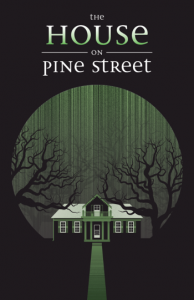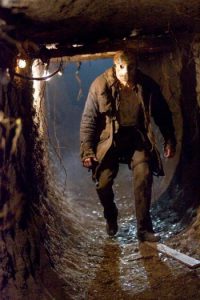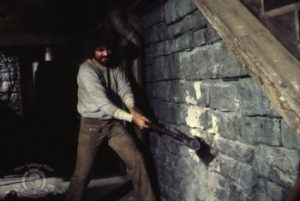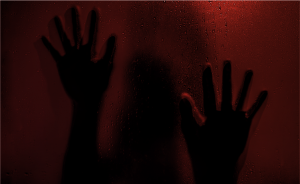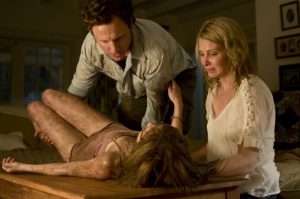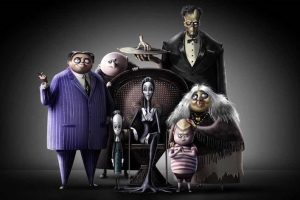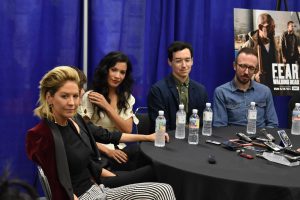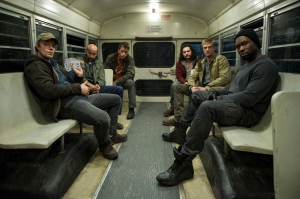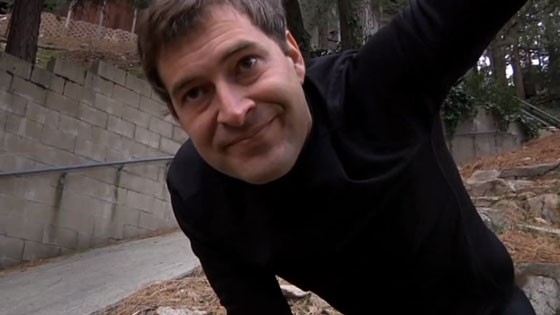
The Creepiest Kind Of Creep
It has been 15 years since the release of The Blair Witch Project and the found footage genre is still going strong. 2014 has seen the release of The Sacrament, V/H/S: Viral, The Houses October Built, Exists, Willow Creek, Devil’s Due, Paranormal Activity: The Marked Ones, Altergeist, The Taking Of Deborah Logan, Mockingbird, The Last Showing, As Above So Below, The Possession Of Michael King, Wer, Inner Demons, and SxTape to name just a few. While some are great genre entries and others just feel like copycats, none of these films pack the originality of Patrick Brice’s Creep.
I would like to thank the Telluride Horror Show and Ted Wilson for programming so many great films this year. Creep was an absolute blast in the theater, the entire audience hung on to each line of dialogue and clung to their seats with uncertainty. The film has a simple enough premise: Aaron (Patrick Brice), a videographer, accepts a Craigslist ad for a day’s shoot. When he meets Josef (Mark Duplass), his subject, it quickly becomes unclear as to what Aaron is really there to film. Creep’s germinating seed came from a real life Craigslist ad, in which an elderly man sought assistance in putting together complicated Ikea furniture. Which is understandable, since those wordless directions are a nightmare. When Duplass arrived at the man’s home, he not only confronted the Swedish diagrams but also someone in need of psychoanalysis. The afternoon turned into a therapy session and it is unconfirmed whether or not the furniture was actually built. From this interesting afternoon the origin of Creep was born.
From Mondo Cane (1962) to Cannibal Holocaust (1980) to Man Bites Dog (1992) we can see the progression of this faux documentary style. These films were always on the fringe. In the case of Cannibal Holocaust they were also heavily banned in many countries. Not until the release of Blair Witch, did studios begin to realize the potential in this faux snuff style. Blair Witch remained an anomaly until the recession hit Hollywood. Between the success of Blair Witch and Paranormal Activity (2007) horror saw the beginning and end of two cycles: the post-modern slasher and torture porn. After the release and subsequent influx of money, due to the popularity of Paranormal Activity, horror came to a crossroads. Independent filmmakers could either utilize their talents remaking the classics or create micro-budget found footage films with complete creative control.
There are many perks that come with making a documentary style film. You can shoot on consumer grade DV camera’s, DSLRs, or more currently with GoPro. The quality of the image becomes secondary to the freedom of convenient shooting. With these films, the audience becomes intimately attached to whomever holds the camera. The first shot of John Carpenter’s Halloween is now the central focus of this new cycle of horror. We are knowingly in the point-of-view of a storyteller. Blair Witch and the Paranormal Activity series harken back to classic horror cinema, in that they skew our perception and scare us with little to no special effects. In the 1963 version of The Haunting, the scariest scene is shot in pure darkness and all we can hear is Julie Harris telling us that Claire Bloom is holding her hand too tight. This same technique is widely used in found footage. We strain to see something and the anticipation is what really horrifies us. To create the realism within these films a lot of directors use scripts that only feature key points, leaving a lot of room for improvisation. Besides shaky cameras, extreme low-lighting, some moderately bad acting, and the frustration/anticipation with the narrative, one of the main problems every found footage film runs into becomes what the audience may construe as stray shots (angles that could not have been captured by the central cameras). Creep is a completely different breed of found footage film in nearly every way.
Mark Duplass is no stranger to improvisational acting. Mark and his brother Jay created The Puffy Chair (2005) during the beginning of the mumblecore era. The Duplass brothers may have not invented the genre, but they knew how to market it. In utilizing ideas originating from Andrew Bujalski’s debut film Funny Ha Ha (2002), the Duplass brothers made their own first film. In 2005, when Mark and Jay were totting their project through the festival circuit they met Bujalski who was touring Mutual Appreciation and they also met another first-time filmmaker Joe Swanberg who was promoting Kissing On The Mouth. Duplass, Bujalski, and Swanberg became friends and eventually all worked together on Swanberg’s Hannah Takes The Stairs. While working on Hannah, Mark met Greta Gerwig, and they hired her for their next project Baghead (2008). Baghead was the first crossover mumblecore and horror film. All of the performances were improvised and while there were a few jump scares and some mystery, the horror aspect remained subtle.

After Baghead, Mark worked on Lynn Shelton’s Humpday (2009) with fellow improvisational actor Joshua Leonard (Blair Witch Project). As an actor, Mark went on to do Your Sister’s Sister (2011), Safety Not Guaranteed (2012), and Zero Dark Thirty (2012). He’s also had reoccurring roles on The Mindy Project, and most currently The League. Despite all of his roles, if you have any doubts about his acting abilities, please just spend a few minutes with his character in Creep. With Creep, we have 82 minutes of pure Mark Duplass brilliance. The film only features Aaron and Josef. Aaron spends most of the time behind the camera, so it is up to Josef to impress us. He does this, seemingly, without any effort. Throughout the duration of the film we constantly juxtapose our own expectations with Josef’s seemingly random actions. When we are walking into a horror film, even if we are not aware of the plot, we have already formed an unspoken list of requirements. We look for the preamble scene to get us hooked into the plot, a bit of character development so we can care about their demise, a few padded kills, eventually a big reveal as to who or what is killing or menacing, and a showdown. Creep doesn’t do any of those things, and that is what makes it a truly rewarding experience.
“Let’s hug first, cause we’re gonna be doing this a lot today.”
The director, Patrick Brice, does an excellent job straying away from any found footage or general horror cliches. There are jump scares, a werewolf mask named Peach Fuzz, a disturbing tubby time with an imaginary baby, scary things in the woods, and plenty of tension, but not how it would normally unfold. Brice assisted Marguerite Phillips with the music supervision on Safety Not Guaranteed and we can assume this possibly put him on Duplass’ radar. Duplass and Brice worked on the screenplay and developed their chemistry with each other. In the end, Duplass produced and Brice directed. The two of them pair well together. Brice not only acts as the videographer, but also as our own attempt at understanding who Josef is and what his intentions may be. There are very few films that can keep your attention with only two characters and there are far fewer that engage you as deeply as Creep. From the first forced hug to an afternoon in the park, Creep does everything right. If you unequivocally loathe everything about found footage films, this may be the only one you need to see. Well, except maybe Creep 2 and Creep 3, that will hopefully be just as good.



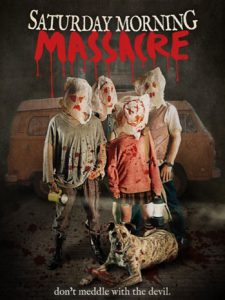
![Love in the Time of Monsters [Review]](https://www.horror-movies.ca/wp-content/uploads/2021/04/Love-in-the-Time-of-Monsters-Poster-350x531-1-198x300.jpg)
![Fantasia 2018: Puppet Master: The Littlest Reich [Review]](https://www.horror-movies.ca/wp-content/uploads/2021/04/PMLR12-UDO-KIER-350x216-1-300x185.jpg)
![[Horror Short Review] Cindy Maples’ Random](https://www.horror-movies.ca/wp-content/uploads/2021/04/Random-Poster-350x524-1-200x300.jpg)
